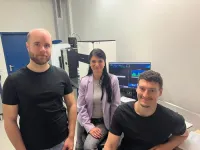(Press-News.org) Ann Arbor, June 24, 2024 – Alcohol consumption is involved in a large proportion of homicides and suicides each year in the United States, but there has been limited evidence on how policies targeting alcohol use influence violence. A statistical analysis in the American Journal of Preventive Medicine, published by Elsevier, indicates that more restrictive alcohol policy environments are associated with a reduction in specific states’ homicide rates.
Lead investigator James P. Murphy, PhD, RAND Corporation, Santa Monica, CA, says, "Previous studies have found a significant relationship between some state-level alcohol policies, such as the level of taxation and age-based restrictions, and crime rates, showing that more restrictive alcohol regulations are associated with a lower likelihood of alcohol involvement among homicide victims. However, the effects of alcohol policies on population-level homicide and suicide rates are not well-understood."
The researchers assessed the association of alcohol policy changes with population-level changes in homicide and suicide rates using the Alcohol Policy Scale (APS), an established and comprehensive alcohol policy index that measures state-year alcohol policy environments. Higher APS percentile scores are indicative of more restrictive alcohol policies. The study sample included all 50 US states. Vital deaths data were drawn from the National Vital Statistics System (NVSS).
To estimate the association between changes in a state’s APS score and changes in its homicide and suicide rates using data from 2002 to 2018, investigators applied a recently developed statistical model that, in similar policy settings, reduces bias in estimating the effects of policy changes on state-level rate outcomes compared to conventional approaches.
Dr. Murphy continues, “We found that adopting more restrictive alcohol policies was associated with a reduction in homicide rates, but not suicide rates. Based on our results, we would expect a nationwide increase in policy restrictions equivalent to a shift from the 25th to 75th percentile of the APS score would correspond with 1200 fewer homicides annually."
More than 74,000 individuals died of homicide or suicide in 2021 in the US. While many homicide and suicide decedents are not tested for blood alcohol content (BAC), among those tested, over 40% had a measurable BAC level. A recent meta-analysis estimated that the percentage of deaths attributable to alcohol among those with known BAC levels or intoxication status was 29% for all homicides (considering alcohol use only by the offender) and 21% for all suicides. These findings suggest that alcohol regulations may have an important role to play in addressing violence-related morbidity and mortality, including the growing number of firearm deaths.
Dr. Murphy concludes, "More restrictive alcohol policies may provide a promising approach to addressing the recent increases in homicides in the US. Further research is needed to identify the particular policies that are most effective, as well as to identify the particular mechanisms through which they affect homicide rates."
END
Study Shows Stricter Alcohol Policies Are Associated with Reduction in Homicides
Findings from a statistical analysis in the American Journal of Preventive Medicine reveal the association of states' alcohol policy changes with population-level changes in homicide rates
2024-06-24
ELSE PRESS RELEASES FROM THIS DATE:
Kennesaw State University researcher to analyze electromagnetic waves with help of grant
2024-06-24
The stereotype of mathematics and mathematicians involves a solitary pursuit of knowledge, but Eric Stachura knows better.
The Kennesaw State University assistant professor of mathematics works on quantitative analysis of electromagnetic waves and keeps a collaborative research practice with colleagues near and far. That partnership has led to a three-year grant worth $223,206 from the Army Research Office, a director of the U.S. Army Combat Capabilities Development Command Army Research Laboratory.
“It is a very collaborative subject, ...
NIH and National Science Foundation to award $15.4 million for RNA research
2024-06-24
The National Institutes of Health (NIH) has partnered with the U.S. National Science Foundation (NSF) to provide approximately $15.4 million over three years for research into the structures, functions and interactions of ribonucleic acid (RNA), as well as the creation of RNA-based technologies. RNA sequencing and the mapping of RNA modifications have gained significant momentum in the genomics community in recent years, with a new report from the National Academies of Sciences, Engineering, and Medicine outlining a roadmap for the field to build technology and infrastructure to allow researchers to more completely study and catalog RNA and its modifications.
“A ...
Study examines acceptability of teleneurology across neurological conditions
2024-06-24
INDIANAPOLIS – One of the first studies to examine patient acceptability of teleneurology and determine factors influencing acceptability across neurological conditions, has found teleneurology was highly acceptable across the full range of patients with different neurological diagnoses, including headache, movement disorders and other neurological symptoms and diagnoses. The study also determined that the more medical complexity -- having additional diseases -- was associated with increased patient satisfaction with teleneurology.
Older patients were as accepting of teleneurology as younger patients, individuals often viewed as more ...
Correcting biases in image generator models
2024-06-24
Image generator models – systems that produce new images based on textual descriptions – have become a common and well-known phenomenon in the past year. Their continuous improvement, largely relying on developments in the field of artificial intelligence, makes them an important resource in various fields.
To achieve good results, these models are trained on vast amounts of image-text pairs – for example, matching the text "picture of a dog" to a picture of a dog, repeated millions of times. Through this training, ...
How cells boost gene expression
2024-06-24
The function of non-coding RNA in the cell has long been a mystery to researchers. Unlike coding RNA, non-coding RNA does not produce proteins – yet it exists in large quantities. A research team from the University of Göttingen has now discovered an important function of antisense RNA (asRNA): the researchers found that asRNA acts as a "superhighway" in cell transport and thus accelerates gene expression. The results were published in Nature.
RNA (ribonucleic acid) plays a central role in the translation of DNA information into proteins. There are different types of RNA, one of which is known as messenger ...
Meet CARMEN, a robot that helps people with mild cognitive impairment
2024-06-24
Video: https://youtu.be/bGKA32TlVXM?si=0PdhaUyOKH33DFbB
Meet CARMEN, short for Cognitively Assistive Robot for Motivation and Neurorehabilitation–a small, tabletop robot designed to help people with mild cognitive impairment (MCI) learn skills to improve memory, attention, and executive functioning at home.
Unlike other robots in this space, CARMEN was developed by the research team at the University of California San Diego in collaboration with clinicians, people with MCI, and their care partners. To the best of the researchers’ knowledge, CARMEN is also the only robot that teaches compensatory cognitive strategies to help improve memory and executive function.
“We ...
NYU creates Center for Mind, Ethics, and Policy
2024-06-24
New York University has established the Center for Mind, Ethics, and Policy, which aims to further our understanding of the sentience and moral status of nonhumans, notably animals and AI systems.
“The world contains quintillions of animals, and in the future, it could contain an even larger number of AI systems,” says Jeff Sebo, CMEP’s founding director and a professor in NYU’s Department of Environmental Studies. “Human activity is increasingly shaping the lives of these beings, and these trends raise important and difficult questions, such as: Which of these beings are sentient, ...
New mathematical proof helps to solve equations with random components
2024-06-24
Whether it’s physical phenomena, share prices or climate models – many dynamic processes in our world can be described mathematically with the aid of partial differential equations. Thanks to stochastics – an area of mathematics which deals with probabilities – this is even possible when randomness plays a role in these processes. Something researchers have been working on for some decades now are so-called stochastic partial differential equations. Working together with other researchers, Dr. Markus Tempelmayr ...
Researchers awarded $2.78M federal grant to improve rectal cancer treatment with artificial intelligence
2024-06-24
CLEVELAND—With a new five-year, $2.78 million grant from the National Institutes of Health and National Cancer Institute, researchers at Case Western Reserve University(CWRU), Cleveland Clinic and University Hospitals (UH) will use artificial intelligence (AI) to better treat rectal cancer patients.
The American Cancer Society estimates about 46,000 people nationally will be diagnosed this year with rectal cancer—the third most common type of cancer in the digestive system, after colon and pancreatic cancer.
By using AI, the researchers intend to derive specific metrics on magnetic resonance imaging (MRI) scans to better understand how ...
Manipulating the frequency of terahertz signals through temporal boundaries
2024-06-24
Terahertz technology could help us meet the ever-increasing demand for faster data transfer rates. However, the down-conversion of a terahertz signal to arbitrary lower frequencies is difficult. In a recent study, researchers from Japan have developed a new strategy to up- and down-convert a terahertz signal in a waveguide by dynamically modifying its conductivity using light, creating a temporal boundary. Their findings could pave the way to faster and more efficient optoelectronics and enhanced telecommunications.
As we plunge deeper into the Information Age, the demand for faster data transmission keeps soaring, accentuated by fast progress in fields like deep learning ...
LAST 30 PRESS RELEASES:
New expert guidance urges caution before surgery for patients with treatment-resistant constipation
Solar hydrogen can now be produced efficiently without the scarce metal platinum
Sleeping in on weekends may help boost teens’ mental health
Study: Teens use cellphones for an hour a day at school
After more than two years of war, Palestinian children are hungry, denied education and “like the living dead”
The untold story of life with Prader-Willi syndrome - according to the siblings who live it
How the parasite that ‘gave up sex’ found more hosts – and why its victory won’t last
When is it time to jump? The boiling frog problem of AI use in physics education
Twitter data reveals partisan divide in understanding why pollen season's getting worse
AI is quick but risky for updating old software
Revolutionizing biosecurity: new multi-omics framework to transform invasive species management
From ancient herb to modern medicine: new review unveils the multi-targeted healing potential of Borago officinalis
Building a global scientific community: Biological Diversity Journal announces dual recruitment of Editorial Board and Youth Editorial Board members
Microbes that break down antibiotics help protect ecosystems under drug pollution
Smart biochar that remembers pollutants offers a new way to clean water and recycle biomass
Rice genes matter more than domestication in shaping plant microbiomes
Ticking time bomb: Some farmers report as many as 70 tick encounters over a 6-month period
Turning garden and crop waste into plastics
Scientists discover ‘platypus galaxies’ in the early universe
Seeing thyroid cancer in a new light: when AI meets label-free imaging in the operating room
Neutrophil-to-lymphocyte ratio may aid risk stratification in depressive disorder
2026 Seismological Society of America Annual Meeting
AI-powered ECG analysis offers promising path for early detection of chronic obstructive pulmonary disease, says Mount Sinai researchers
GIMM uncovers flaws in lab-grown heart cells and paves the way for improved treatments
Cracking the evolutionary code of sleep
Medications could help the aging brain cope with surgery, memory impairment
Back pain linked to worse sleep years later in men over 65, according to study
CDC urges ‘shared decision-making’ on some childhood vaccines; many unclear about what that means
New research finds that an ‘equal treatment’ approach to economic opportunity advertising can backfire
Researchers create shape-shifting, self-navigating microparticles
[Press-News.org] Study Shows Stricter Alcohol Policies Are Associated with Reduction in HomicidesFindings from a statistical analysis in the American Journal of Preventive Medicine reveal the association of states' alcohol policy changes with population-level changes in homicide rates





